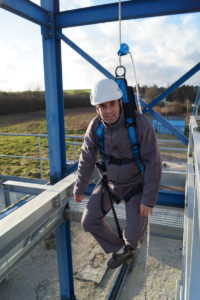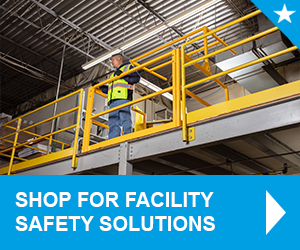
Fall protection is one of the most important aspects of workplace safety. OSHA has specific regulations in place that employers like yourself must follow. When it comes to falls, you are responsible for mitigating the dangerous slips, trips, and falls that can lead to injury—not to mention slow down work productivity, incur fines, and damage your reputation.
Fortunately, there are lots of options available to keep your workers safe, from self retracting lifelines, shock absorbing lanyards, guardrails and self closing gates. But which is the best for your job application?
First, Employer Obligations
Protecting employees from dangerous workplace hazards is required by OSHA. Since fall protection frequently tops the chart as one of the most cited violations, it’s worth taking a moment to review and make sure your company is in compliance. For general industry, protection like guardrails, a fall arrest system, or a fall restraint device must be used whenever a worker is engaged in activities 4 feet above the floor level. For construction workers, like guardrails, a fall arrest system, or a fall restraint device must be used whenever a worker is engaged in activities 6 feet above the floor level. Regardless of the industry you operate in, protection also has to be provided around and above hazardous equipment or machinery, no matter the distance.
Let’s Clarify the Options
After completing your hazard analysis, it is your responsibility as an employer, to choose the appropriate fall protection systems for each job application. In order to do this effectively, you will need to understand what each type of fall protection system does, how it is used, and where it is most effective. Once you have that information, you’ll be able to make the right choice to keep your employees safe.
Fall Restraint vs. Fall Arrest
Fall Restraint Systems
Fall restraint systems prevent the user from falling any distance, by not allowing the worker to reach any unprotected side or edge. It can also be used to keep a worker within the confines of an aerial lift. Usually, the connections are shorter and adjustable to be restrictive.
Fall Restraint Systems
Fall arrest systems are designed to stop the fall and absorb the energy. Body Support, Connectors, Anchors, and Rescue are all a part of the fall arrest system. A fall arrest system may be used in tandem with other fall protection devices like guardrails and/or a self closing gate, but this isn’t always the case. In some instances, workers need to access locations that are not protected by guardrails or other passive fall protection.
With both fall arrest and restraint systems, you’re not only responsible for providing this type of equipment when appropriate, but also for providing training for workers on their proper use. Training does more than just teach your workers how to inspect, wear, and use the equipment properly; it also ensures that they are alerted to the potential fall hazards. Initial training is required, as well as any time you introduce a new hazard or new equipment. Refresher training is just as important as the initial training.
Fall Prevention vs. Fall Protection
Fall prevention is anything that eliminates a hazard altogether. This can be done by limiting access to fall hazards through guardrails or other barriers, a self closing gate, or through a fall restraint system that doesn’t allow access to any unprotected side or edge.
It is worthwhile to note that while both guardrails and restraint systems are examples of fall prevention (as in, they prevent a fall), they still fall under the umbrella of fall protection. In fact, any step you take that prevents, or protects your workers from a fall is considered fall protection.
Passive fall protection is anything that protects a fall without action from the worker, like guardrails and a self closing gate or a safety net. While both offer fall protection, only guardrails and a gate will prevent a fall.
Active fall protection is anything that requires active participation from the worker, i.e. using a fall restraint or fall arrest system. But while they both protect the worker, only a fall restraint will prevent a fall.
What’s more, according to OSHA, proper fall protection also means employers must:
- Provide working conditions that are free of known dangers.
- Keep floors in work areas in a clean and, so far as possible, a dry condition.
- Select and provide required personal protective equipment at no cost to workers.
- Train workers about job hazards in a language that they can understand.
The Importance of Fall Protection
We all know that injuries from falls can cost organizations thousands by way of medical and legal expenses, not to mention lost productivity, and OSHA fines and penalties. But a history of fall-related injustices can also damage your reputation. Fortunately, all of this is easily avoidable with preparation. This doesn’t just mean having the right equipment like harnesses, self retracting lifelines, guardrails, etc, available and installed. It means having a full plan, including awareness, safety training, and reporting. And no matter what you choose, you’ll be on your way to creating a safety-first culture within the workplace along with saving a life/lives, from the very top of your leadership team right down to your newest hire.











